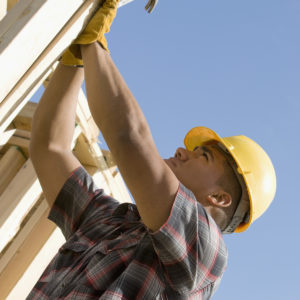Conduct a thorough job safety analysis of all tasks involving heights. Begin by deciding how the job will be done, what tasks will be involved and what safety equipment will be needed to complete each task. Have a first aid kit on hand along with emergency numbers.
When hiring subcontractors:
Ensure a valid amount of experience.
Review task expectations and completion requirements.
Develop a subcontractor contract to use to shift liability if the subcontractor is at fault for a mistake.
PROVIDE EQUIPMENT
When working at heights greater than six feet, workers are at risk for serious injury if a fall occurs. Safety railings should be in place and scaffolding should be fully planked. Safety equipment must match the duties and job being performed.
Additional safety equipment tips:
• Take into consideration the weight of the users and ensure standards are met.
• Workers should wear a personal fall arrest system to avoid possible injury when working at heights greater than six feet, such as rooftops, ladders, and walls.
• Hard hats should be worn to prevent head injuries.
• Equipment must be properly maintained and regularly inspected.
PROPER TRAINING
Train everyone to use equipment safely (including any subcontractors on site)
Falls can be prevented when everyone on site understands proper set-up and safe use of
equipment. Train workers in hazard recognition and in the care and safe use of ladders, scaffolding, fall protection systems and other equipment they’ll be using on the job.
Good practices for ladders:
• Use the correct ladder for the job and visually inspect for any defects.
• Erect at the correct angle.
• Secure the ladder at the top.
• Ladders should extend a minimum of 36” above the top landing.
• Avoid over-reaching by positioning the ladder close to your work.
• Protect the base of any ladder to prevent pedestrian or autos from bumping into it.
• Do not work off of ladders on uneven ground without securing the bottom of the ladder.
JOBSITE HOUSEKEEPING
Check the jobsite floor and ground daily. Remove any ice, snow or debris to prevent trips or falls.
Secure tools when working from heights.
Develop habits of keeping tools off the floor and properly stored when not in use.
Stack materials securely to prevent sliding or falling.
Use security signs to identify restricted and dangerous areas.
Provide separate and designated containers for collection of trash, oily and used rags.
Dispose of waste on a frequent and regular basis.
Be sure to secure the jobsite when you leave for lunch, or for the day.
Ladders put away.
Holes securely covered and signs posted.
Barricades placed in front of open areas.
Unplug and secure tools.
Remove keys and lock excavation equipment.
Download a printable version of these tips here: Prevent Job Site Injuries